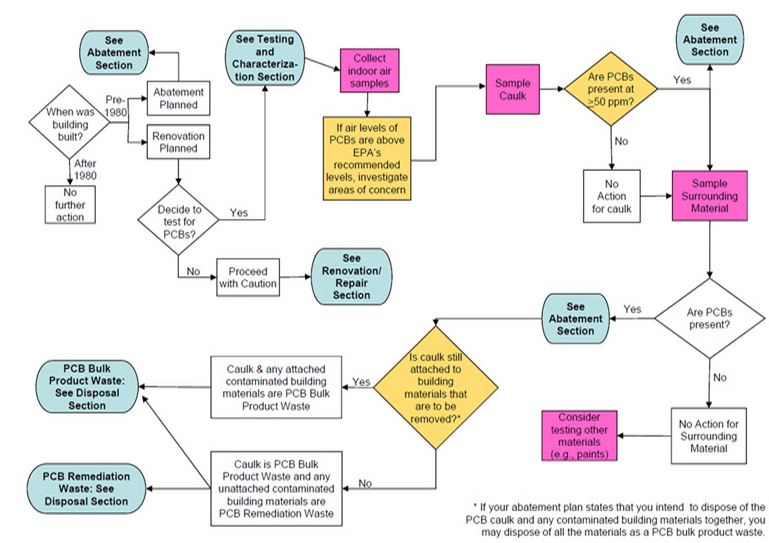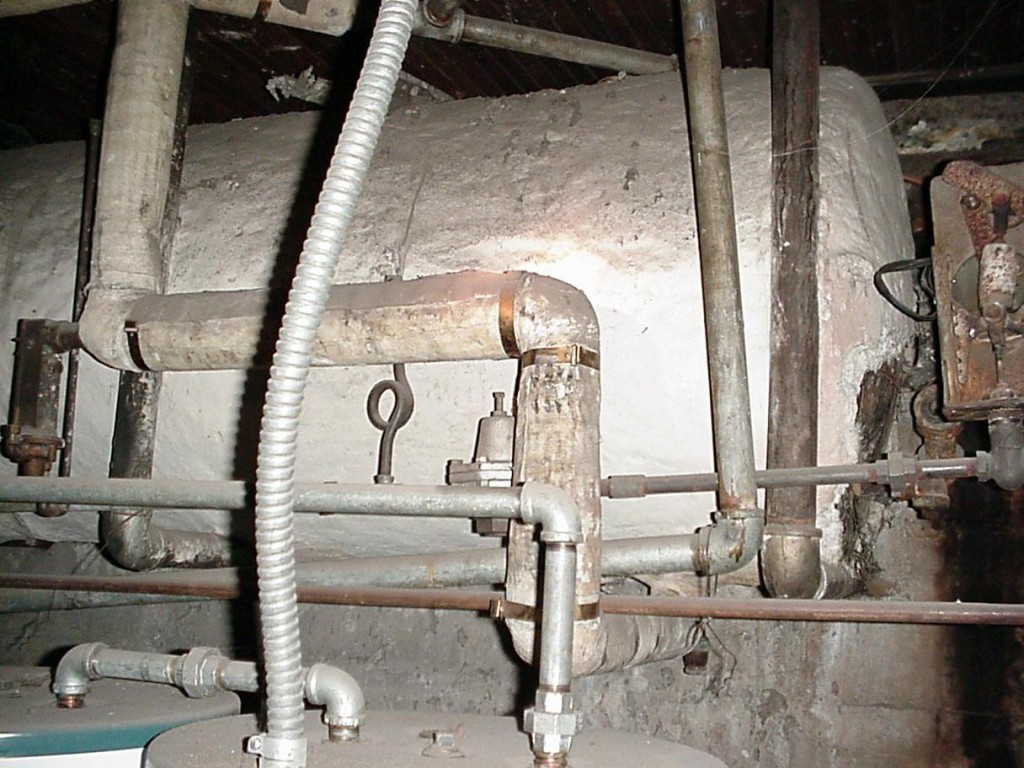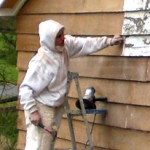Entries tagged with “EPA”.
Did you find what you wanted?
Wed 26 Jun 2013
Posted by admin under Air Monitoring, Building Survey, EPA, Exposure, IAQ, industrial hygienist, Management, NIOSH, occupational hygiene, PCB, Risk, Uncategorized
Comments Off on PCBs in caulk
Yep. Polychlorobiphenyls (PCB) are found in caulking. Typically buildings before 1979 have this caulk. (EPA Facts about PCB in Caulk) The only way to know is to test. BUT, wait!
Either:
- Assume you have it and renovate with caution. Or,
- Have the air tested for PCBs in the air.
Do not have a bulk sample taken. You should ask for an exposure assessment to be performed (air monitoring) by a qualified industrial hygienist. The reason is two-fold.
- The potential for the hazard is airborne. In most instances, people aren’t getting exposure from any other method.
- By measuring the air, you account for any other sources of PCBs (paint, ballasts, oils, ceiling tiles).
Most of this caulk is found in outdoor uses (high grade) in older buildings up to around 1980-ish. If an airborne exposure assessment finds levels below the acceptable rules & recommendations (depends on age & location), you may continue with your project. Of course, you would take appropriate precautions, like these recommendations from the EPA. They also have a very nice flow chart. Just like a choose-your-adventure book, make sure you don’t fall into the “Abatement” box!

Fri 16 Nov 2012
Posted by admin under Air Monitoring, Biological Monitoring, Dust, EPA, Federal OSHA, HEPA, Lead, OSHA, Personal Protective Equip (PPE), Respirators, Safety Programs, Training, Uncategorized
1 Comment
You must follow both. (I’ve mentioned this before)
OSHA’s rules are very detailed and apply to any amount of lead in paint (even less than 0.5%) if you are disturbing it. The only time OSHA rules do not apply is:
- if you are working as a sole-proprietor (no employees), or
- if you are in some other country.
EPA’s rules are just a start. They apply to any residential facility where there are kids under the age of 6. OSHA’s rules are much more comprehensive and protective. (in some instances, overkill)
To EPA’s credit, they have done a great job of marketing and letting contractors know they insist on compliance. OSHA, on the other hand, only inspects 2% of businesses/year and does virtually no marketing. The chances of OSHA showing up on any given jobsite, is nearly 0%.
OSHA’s rules are very complete and comprehensive. You WILL need air monitoring, blood monitoring, PPE, change areas, water/sanitation, and training. The worst thing you can do is NOT follow the OSHA rules, find overexposures, and then try to “make up” for it. From my experience this scenario is a bad place to be, and happens all the time.
Wed 7 Nov 2012
The answer is Yes.
If you are working with lead (in any amount) and you are performing any of the “trigger tasks” in construction = you must follow OSHA rules. Trigger tasks are demolition, removal, encapsulation, new construction, installation, cleanup, abrasive blasting, welding, cutting, torch burning, transporting, storing, heat gun work, sanding, scraping, spray painting, burning, welding, etc. What about the EPA rules (RRP)? Look here.
The only exceptions to not measuring employees blood lead are:
- On the first day of work activity, you perform air sampling (for the full shift) and can prove the airborne levels are below the Action Limits (<30 ug/m3)…or,
- OR…If you have relevant historical data and can prove your airborne levels during the same tasks are below the Action Limit (within the last 12 months). Relevant historical data must be REALLY relevant. Like, same work activity, same amount of lead in the paint, same general size/location, etc, etc.
These are the only exceptions.
If you choose to NOT perform blood lead monitoring the downsides are:
- employees might already have dangerous levels of lead in their system, and you expose them to more
- measuring blood lead levels after the exposure may indicate higher baseline blood lead levels -and you might have to pay for exposure which wasn’t your fault
- if overexposed, and they have high blood levels – you might have to also check their family’s blood lead levels
More information on blood lead testing from my earlier post.
Mon 24 Sep 2012
Posted by admin under Air Monitoring, Asbestos, Management, OSHA, Safety Programs, Training
Comments Off on I have asbestos, but it is less than 1%.
Assume your general contractor reports that he has found a material (floor tile, popcorn ceiling, etc) with less than 1%. He wants you to remove it with the rest of the demolition because, as you know, “…if it’s less than 1%, it’s NOT considered asbestos containing!”.
Are you ok to remove it?
Yes, and no. There is more to consider. The “1% rule” (as it’s called) as it is called states that they only regulate asbestos containing materials if they contain more than 1% of asbestos. Here are a few other considerations:
- OSHA definition. Don’t get stuck on the definition. If you have employees, you must still follow parts of the OSHA rules. At a minimum, you must train your employees, work practices, clean-up and disposal requirments. More details on training here.
- How were the samples taken? If one bulk sample shows less than 1% asbestos, you still might have a problem. According to the EPA/AHERA sampling rules, some types of materials must have up to 7 samples taken. This rule is in place because, back in the day, asbestos was added to joint compound (or anything similar) and it could really vary in amount according to where you take the sample. In addition, OSHA does not allow for composite sampling (combining the layers).
- Do you know that 0.99% asbestos is still bad for you? Asbestos is a carcinogen. The greater the exposure, the greater the risk of disease. Any exposure could be the one to cause the disease. If the material is friable and you are disturbing it, I would NOT recommend performing that activity. Hire an abatement contractor.
- Finally.Let’s assume it’s non-friable, you are not going to disturb it (when removing it) and it’s less than 1%. What will you do if your neighbor next door decides to call OSHA/EPA? Do you have a written plan and procedure? Have your employees been trained on the hazard? How to remove it? How to dispose of it? …Sometimes bad publicity will get you in worse trouble than any monetary fine.
 
Wed 25 Jul 2012
As I have said in an earlier post, some OSHA, EPA, and MSHA rules are a good fit. They blend well with health research, scientific technology, good practices, and a low-cost-of-compliance for employers. Other rules are just bad. They are  totally out of date, not protective enough, or just not feasible/practical. Here’s my plug for a good safety manager/industrial hygienist – A good one will know which rules/guidelines to follow.
The New York Times (July 19, 2012, Cara Buckley) recently wrote an article on the US noise standards which are not protective enough for employees. In construction we also have three additional problems.
- hearing loss is expected (or at least assumed in certain fields – carpenters, sheetmetal, ironworkers, etc.) and,
- work shifts are usually over 8-hours. Noise exposure is usually calculated on an 8-hour time weighted average. During the busy months, an 8-hour work day is rare. It’s at least 10, maybe 12-14 hours. This doesn’t allow your ears to “rest” between shifts. For more information on extended work shifts go here.
- extracurricular activities contribute to overall hearing loss – my point is that most construction workers don’t sit at home at the end of their shift. Almost everyone I know in construction is involved in one of these activities: hunting, shooting, motorcycles, water sports, yard work, cars, wood working/cutting, concerts, music, etc. Each of these activities contribute to their overall hearing loss, and again, doesn’t allow your ears to “rest”.
…which reminds me that I need to keep a set of ear plugs in my motorcycle jacket.

Tags: ACGIH, dBA, dosimeters, EPA, hearing loss, IH, noise, OSHA, safety, sound, sound level, standards, TWA
Fri 13 Apr 2012
Posted by admin under EPA, Lead, OSHA
[2] Comments
Who has jurisdiction over lead based paint? Are the EPA’s lead rules all I need to follow? Or, do I follow OSHA?
Well, the short answer (for those in construction) is YES. Usually OSHA, but maybe both EPA and OSHA (*and others, HUD, etc).
OSHA’s focus (as I’m sure you know) is to protect employees. If you are removing leaded on your own home, OSHA has no jurisdiction. However, if you have employees and are working with lead based paint, you must follow OSHA.
The EPA is focused on the environment (of course). They have implemented (April 22, 2008) a rule called the Renovation, Repair & Painting Rule. This rule applies when you are working on any facility which effects kids under the age of 6. If you are contractor looking to work on a project (s) with this demographic, you need to be certified by the EPA. Here is a good starting spot.
It is interesting (maybe just to me) but the EPA has very little enforcement, compared to OSHA. Yet, most people are very aware of the EPA rule. In contrast, I find contractors working with leaded paint who don’t know that they are under OSHA’s rules. I suppose the EPA has done a great job of marketing.
Another interesting comparison is that the EPA and OSHA rules are actually very similar. There are differences, but in general, if you are following the OSHA rules correctly, you are most likely very close to complying with the EPA. (one difference: the EPA requires certification)





